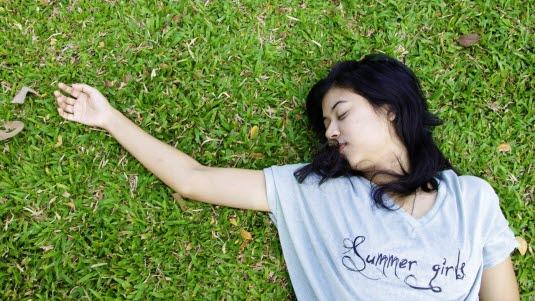Informasjon, veiviser
15 prosent av alle barn under 18 år har hatt minst ett tilfelle av bevissthetstap.
Besvimelse hos barn og unge, veiviser
Hjernen klarer seg ikke lenge med lav blodforsyning. Om hjernen får for lite blod, mister vi bevisstheten og faller om. Liggende vil blodet lettere strømme til hodet og hjernen når det ikke trenger å overvinne tyngdekraften.

Sist oppdatert:
11. okt. 2018
Hva er besvimelse?
- Besvimelse (synkope) er et forbigående bevissthetstap som vanligvis fører til at vedkommende siger sammen eller faller over ende. Besvimelsen inntreffer plutselig, og den går over av seg selv i løpet av sekunder til få minutter.
- Episoden skyldes langsom puls, blodtrykksfall og utvidelse av blodårene i kroppen. Resultatet blir at mindre blod strømmer til hjernen, og vi besvimer.
Annonse
Forekomst
- Besvimelse hos barn og unge voksne er vanlig. 15 prosent av alle barn under 18 år har hatt minst ett tilfelle av bevissthetstap. Det tilsvarende tallet hos unge voksne er 20-40 prosent. Omtrent 5 prosent av småbarn har hatt anfall der de har «holdt pusten».
- Blant noen ungdommer går det sport i det å besvime og for å oppnå det gjør de bruk av ulike teknikker.
Dette dokumentet er basert på det profesjonelle dokumentet Synkope hos barn og unge voksne . Referanselisten for dette dokumentet vises nedenfor
Referanser
- Schuster P. Synkope hos barn og unge voksne. Tidsskr Nor Lægeforen 2006; 126: 2250-2. PubMed
- Salemo JC, Coleman B. Causes of syncope in children and adolescents. UpToDate, last updated Dec 03, 2013. UpToDate
- Holt J, Nessestrand I. Synkope. Akuttveileder i pediatri. Sist revidert 2012. www.helsebiblioteket.no
- van Dijk JG. Explaining syncope: faints need not confuse. Europace 2005; 7: 392-5. PubMed
- Friedman KG, Alexander ME. Chest pain and syncope in children: a practical approach to the diagnosis of cardiac disease. J Pediatr 2013; 163:896. PubMed
- Brignole M, Alboni P, Benditt DG et al. Guidelines on management (diagnosis and treatment) of syncope - update 2004. Executive summary. Eur Heart J 2004; 25: 2054-72. European Heart Journal
- Strieper MJ. Distinguishing benign syncope from life-threatening cardiac causes of syncope. Semin Pediatr Neurol 2005; 12:32. PubMed
- Tretter JT, Kavey RW. Distinguishing cardiac syncope from vasovagal syncope in a referral population. J Pediatr. 2013;163:1618-1623. PubMed
- Rose MS, Koshman ML, Spreng S et al. The relationship between health-related quality of life and frequency of spells in patients with syncope. J Clin Epidemiol 2000; 53: 1209-16. PubMed
- Mivelaz Y, Di Bernardo S, Pruvot E, et al. Brugada syndrome in childhood: a potential fatal arrhythmia not always recognised by paediatricians. A case report and review of the literature. Eur J Pediatr 2006; 165:507. PubMed
- Probst V, Denjoy I, Meregalli PG, et al. Clinical aspects and prognosis of Brugada syndrome in children. Circulation 2007; 115:2042. Circulation
- McLeod KA. Syncope in childhood. Arch Dis Child 2003; 88: 350-3. PubMed
- Cooper P (Chairman). NICE clinical guideline 109, Transient loss of consciousness (‘blackouts’) management in adults and young people. London: National Institute for Health and Clinical Excellence, MidCity Place, 71 High Holborn, London WC1V 6NA, 2010.
- Haugaa KH, Berge KE, Fruh A et al. Kardiale kanalopatier - diagnostikk og behandling. Tidsskr Nor Lægeforen 2005; 125: 2778-81. Tidsskrift for Den norske legeforening
- Gemayel C, Pelliccia A, Thompson PD. Arrhythmogenic right ventricular cardiomyopathy. J Am Coll Cardiol 2001; 38: 1773 - 81. PubMed
- Aksnes TA, Nodenes K, Gjesdal K. Bruk av vippetest ved utredning av synkope Tidsskr Nor Lægeforen 2000; 120: 803-6. PubMed
- Benditt DG, Sutton R. Tilt-table testing in the evaluation of syncope. J Cardiovasc Electrophysiol 2005; 16: 356-8. PubMed
- Gregoratos G, Abrams J, Epstein AE et al. ACC/AHA/NASPE 2002 guideline update for implantation of cardiac pacemakers and antiarrhythmia devices - summary article: a report of the American College of Cardiology/American Heart Association Task Force on Practice Guidelines (ACC/AHA/NASPE committee to update the 1998 Pacemaker guidelines). J Am Coll Cardiol 2002; 40: 1703-19. PubMed
- DiMario FJ jr. Prospective study of children with cyanotic and pallid breath-holding spells. Pediatrics 2001; 107: 265-9. Pediatrics
- Mocan H, Yildiran A, Orhan F et al. Breath holding spells in 91 children and response to treatment with iron. Arch Dis Child 1999; 81: 261-2. PubMed